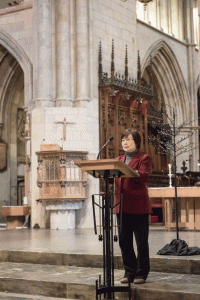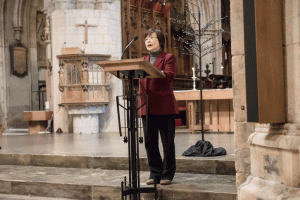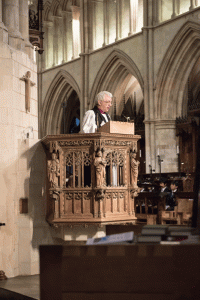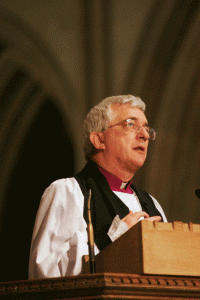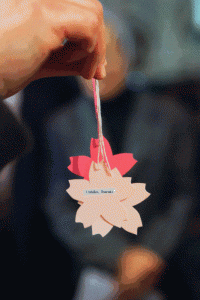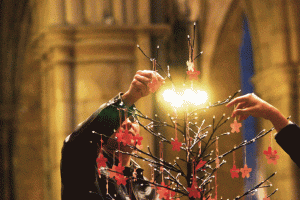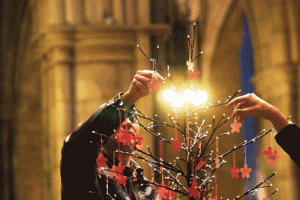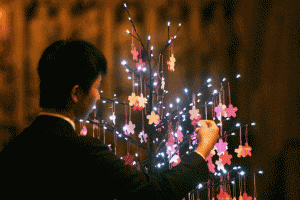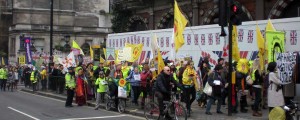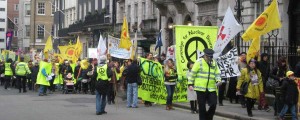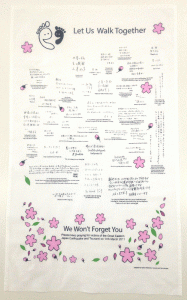Original Japanese written by staffer
The English below written and arranged by Heeday, based on the original Japanese
The English edited by Rev. Dr. Henry French, ELCA

The Year 5 Memorial Service of the 2011 Disaster of Eastern Japan was held 0n February 6th, 2016, at Southwark Cathedral, located close to London Bridge.
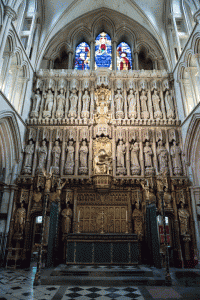
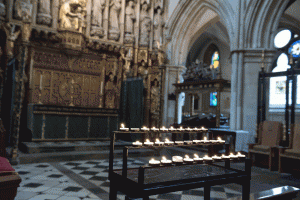 (Photos by Shu Tomioka and Shin Adachi)
(Photos by Shu Tomioka and Shin Adachi)
At the service, Kay Ikezumi, the secretary general of the Project on Nuclear Power and Radiation, was a guest speaker. She described how the areas and refugees hit hard by the 2011 meltdown of Fukushima Daiichi were presently doing.
A booth was set up within the cathedral where the Project presented what it is doing. Photos showed how many of those affected by the March 2011 disaster and volunteer helpers have befriended each other. Also, tea towels imprinted with the words “Let Us Walk Together” were displayed. The towels were also imprinted with comments by both those affected by the disaster and volunteers who help them.
This was the second memorial service held to remember the disaster. The first one was held in 2013. Five years after the tragedy, in Great Britain, far from the site of the disaster, many people came together for the memorial service to remember those affected by the disaster and their families. The service was proposed by both Britons and Japanese nationals living in the UK.
While Ms. Ai Ito, a soprano living in Paris, was singing, Bishop Michael Ipgrave began the memorial service.
Click here for the bishop’s homily ➡ Original / Japanese translation
After the homily, while the organist played a tune well-known to many Japanese called “Furusato (hometown)” on the pipe organ, all the participants tied a tag, in the shape of a cherry blossom, onto two trees beside the altar. This moving event was led by Mr. Motohiko Kato, the envoy extraordinary and minister plenipotentiary at the Japanese embassy to the UK, and the Mayor of Southwark.
Trees of prayer
The cherry blossom tags were distributed to all the participants before the service began. Each tag carried the name of a place where the 2011 disaster had claimed one or more human lives. It was a seal of the promise to remember every life lost, his/her family, and every person who was affected by the tragedy and is still experiencing hardships.
The fully ornamented trees were illuminated to represent the hope of rebuilding those hard-hit areas.
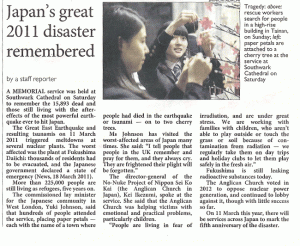
Events around the worship
Before and after the service, meetings to report on the harm the Fukushima Daiichi meltdown had caused and what the Project was doing to counteract that harm gathered at several places.
At one of the these meetings, someone from a network named “JAN UK” greeted us. It is a network of individuals voicing their opposition to nuclear energy here in the UK, a country which still hosts nuclear power plants. Many of the network members are Japanese nationals.
To visit the website of JAN UK, click here ➡
To tweet, click here To tweet, click here ➡
Since August 2012, the network’s members have been gathering in front of the Japanese Embassy in the UK to protest against nuclear energy. Since October of the same year, they have been active before the London office of TEPCO as well.
JAN UK is a network rather than an organization. It has no representative. Under its banner, those concerned about nuclear power get together, as much as they can. One female participant said, “Doing nothing would be giving unspoken approval to nuclear power, which stands upon the sacrifices of many, as well as upon the socio-economic system that builds nuclear power plants. In serious agony, I am looking for what I can do to change all that.”
Tea towel of wishes
These tea towels carry messages from both those involved in the Project and from people at “Support Center Shinchi Gangoya.”
It was Yuki Johnson, an Anglican currently living in the UK, who produced the tea towels. Her wish is that, five years following the 2011 disaster, Fukushima remain in people’s minds.
The towel sold for ₤4.5 apiece and, after deducting production costs, Yuki kindly donated the money raised to the Project .
The Japanese author’s wish
We are now witnessing the sad fact that the 2011 disaster and the consequences of the nuclear meltdown are gradually disappearing from the minds of many. Still, as shown above, our Project has been and still is supported by warm help from many concerned people. Our gratitude extends to all those who so generously help us.

